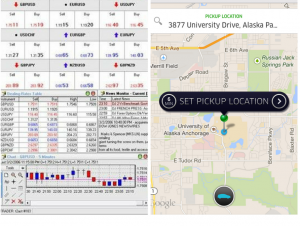[spb_text_block animation=”none” animation_delay=”0″ simplified_controls=”yes” custom_css_percentage=”no” padding_vertical=”0″ padding_horizontal=”0″ margin_vertical=”0″ custom_css=”margin-top: 0px;margin-bottom: 0px;” border_size=”0″ border_styling_global=”default” width=”1/1″ el_position=”first last”]
Clients usually overestimate the risks of using a mobile apps for business – developers, on the other hand, tend to underestimate them. Your task as a consultant is to meet both of them halfway. And, in order to do so, you should be aware of the industry standards, best practices, and user-generated issues that would have an impact on security.
[/spb_text_block] [spb_image image=”17750″ image_size=”full” frame=”noframe” caption_pos=”hover” remove_rounded=”yes” fullwidth=”no” overflow_mode=”none” link_target=”_self” lightbox=”no” intro_animation=”none” animation_delay=”200″ width=”1/1″ el_position=”first last”] [spb_text_block animation=”none” animation_delay=”0″ simplified_controls=”yes” custom_css_percentage=”no” padding_vertical=”0″ padding_horizontal=”0″ margin_vertical=”0″ custom_css=”margin-top: 0px;margin-bottom: 0px;” border_size=”0″ border_styling_global=”default” width=”1/1″ el_position=”first last”]
There are many ways to secure an enterprise mobile application, and in most of the cases, some combination of these methods will lead to a truly secure outcome.
If part of a solid IT security policy, or, rather, a mobile security framework, that’s a good start. Then comes the assessment of risks regarding the mobile applications and finding the right solutions to control the security of all the elements of the mobile workflow.
Prevention and protection is of equal importance: you can read about the basics of this concept in a previous SCOLVO blog. This time, we present the major checkpoints mobile solutions need to pass to be considered secure.
Checkpoint 1: The Code is Secure
The absolute minimum due diligence from the part of a mobile app developer is to use secure codes. During the development, there are several steps to ensure that no malicious code could appear at any stage of the process, through reverse engineering or tampering or in any other way.
By encrypting the code, it will hardly be accessible to those with bad intentions. Audits, reviews, penetration testing, and releases pending on security expert approvals can further enhance security and ensure that vulnerabilities are discovered on time.
When a code is publicly readable, its flaws might become attack surfaces and the application itself modified. Then the business runs the risk of users downloading the modified version and become targets of attack.
Checkpoint 2: The Data is Secure
In the case of enterprise apps, the data, often sensible with significant business value, is stored on the users’ devices. Developers need to use special encryption algorithms (SCOLVO, for example, uses elliptic curve cryptography) to protect these data from misuse. Data can also be encrypted by its elements to make its transfer safer.
Also, the algorithms used for encryption should be up-to-date, in order to provide maximum security: good development teams closely monitor the latest trends and best practices industry-wide to select the most effectives security solutions.
Data leaking from mobile devices and apps is a threat that should be taken seriously. In a report by Lookout and Ponemon Institute, the economic risk of a mobile data breach is put as high as $26.4mn, adding the two-thirds of the companies had already had some kind of mobile breach to pay for.
Checkpoint 3: The Access is Secure
We all know how insecure passwords can be: so many users are just unaware of the security risks certain practices or their devices pose. Still, poor password management can be fought with encryption methods, but even better is a role-based access that provides an extra layer of security by only allowing the user to see the information essential to his or her job. Different profiles can then be managed by an Identity Access Management system.
According to Gemalto’s Breach Level Index, identity theft is the most common type of breach with a 58% share of the total and counting.
The good news is that even small, competent teams that use the right tools can effectively protect their business users from failing this way by encrypting sensitive information in configuration files, and making sure all security settings are turned to the maximum by default.
Checkpoint 4: The Communications are Secure
Communications between the mobile app and the backend systems or third-party services should be secured by proper encryption and authentication. A common protocol is a basic authentication with SSL/TLS encryption, while communication in production environments can be made secure by the involvement of certificate authorities.
Checkpoint 5: The Third-Party Services are Secure
In protecting an application against malware or fighting attacks, a third-party service provider, usually for cloud infrastructure, can play a key role. Since they prone natural targets for a security breach, developers should be aware of the security and risk management programs of their provider. (At SCOLVO, we choose Amazon Web Services, the leading IaaS provider in Germany, that meet the major security certificates’ criteria and is regularly audited.)
They also have to assess the risk of each provider, depending on the sensitivity of the data they have access to, especially since the number of data breaches associated with these providers have increased by 22%, a PwC report shows. Furthermore, advertising and analytics can be gateways to security breaches, as they usually involve a better-than-average amount of data transfer.
While cutting back on these activities and sticking to the core functions can be a viable solution to decrease the risks, it is not always the most wanted. Regular monitoring of activities of the application by the development team and saving data to other storages allows the organization to prevent attacks or fixing vulnerabilities in time.
Let your clients enjoy the power of mobility without complications – Join the SCOLVO partner community today!
[/spb_text_block]




